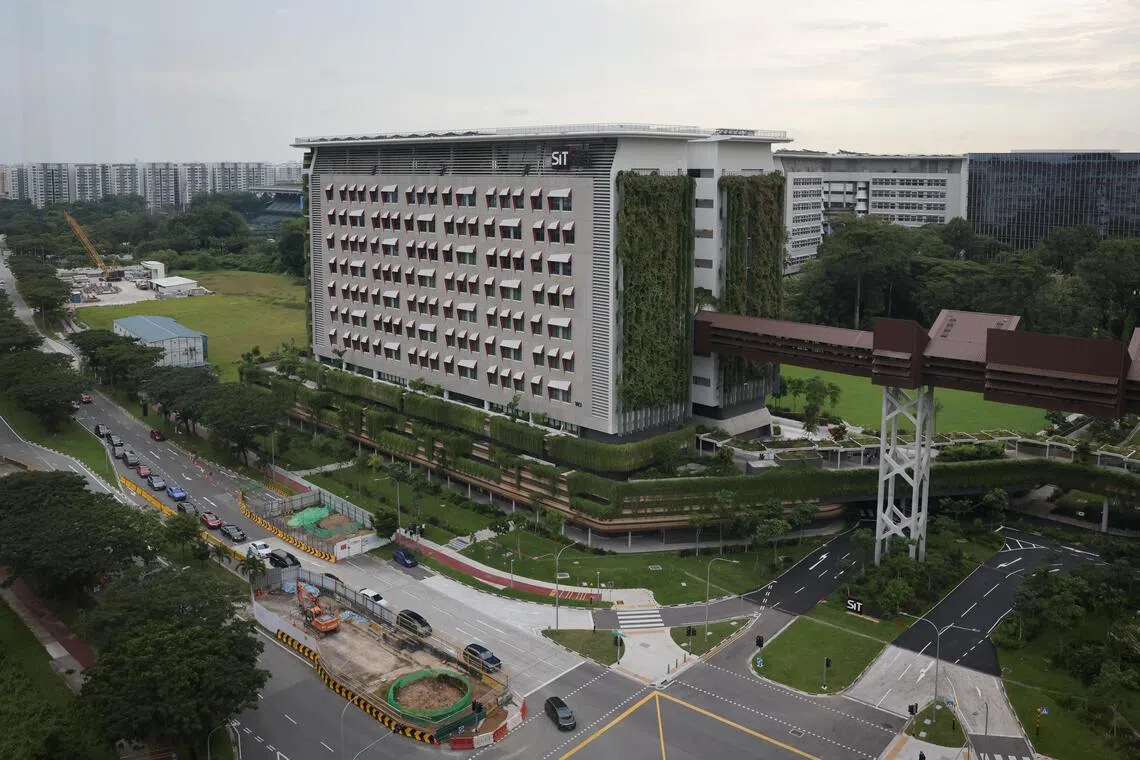Higher salaries, but slight dip in full-time employment for SIT’s class of 2024
Sign up now: Get ST's newsletters delivered to your inbox

Overall, 87 per cent of SIT graduates found employment in 2024, a slight dip from 91.6 per cent in 2022.
ST PHOTO: ONG WEE JIN
Koh Ming Lun
Follow topic:
- SIT graduates in 2024 saw a rise in median monthly salary to $4,200, the highest ever, but a slight dip in employment rates to 79%.
- 56 per cent of SIT undergraduates in 2024 who were offered advance jobs from their employers in the Integrated Work Study Programme accepted the offers.
- Health & Social Sciences graduates had the highest employment rate (98%), while accountancy and engineering graduates also saw salary increases.
AI generated
SINGAPORE – Fresh graduates from the Singapore Institute of Technology (SIT) in 2024 drew higher starting salaries, although fewer of them landed jobs after graduation.
Those who got full-time permanent jobs earned a median monthly salary of $4,200 in 2024, up from $4,000 in 2023 and $3,950 in 2022, according to SIT’s latest graduate employment survey released on Oct 1.
This marks the highest median gross monthly salary ever reported for SIT graduates.
The survey also showed a slight dip in the employment rate of fresh graduates, with 79 per cent of SIT’s graduating cohort securing full-time permanent work within six months of graduation, down from 81.4 per cent in 2023.
Overall, 87 per cent of SIT’s graduates found employment – including part-time and freelance work – compared with 88.5 per cent in 2023.
In a statement, the university said that 56 per cent of undergraduates in 2024 who were offered jobs in advance from their employers in the Integrated Work Study Programme (IWSP) accepted the offers.
This is higher than the 49 per cent in 2023.
A total of 12,806 students have completed the IWSP, with the number of participants growing each year. The programme allows students to gain real work experience for up to a year.
The annual Joint Autonomous Universities Graduate Employment Survey was conducted by SIT between March 1 and May 20.
Of the 2,706 graduates from SIT’s class of 2024, 78 per cent, or 2,113, took part in the survey.
The survey findings for other autonomous universities were released earlier in 2025, due to their different academic calendars.
Fresh graduates from the National University of Singapore, Nanyang Technological University, Singapore Management University, Singapore University of Technology and Design, and Singapore University of Social Sciences also had a higher median gross monthly salary of $4,500 in 2024, up from $4,317 in 2023.
Similar to SIT’s findings, fewer graduates from these universities found employment. Overall, 87.1 per cent of graduates – including those who secured part-time and freelance work – were employed within six months of graduating in 2024, down from 89.6 per cent in 2023. And 79.5 per cent of their graduates in 2024 secured full-time employment, down from 84.1 per cent in 2023.
Graduates from SIT’s Health and Social Sciences cluster had the strongest overall employment rate of 98 per cent. Those from SIT’s accountancy and engineering programmes also had higher salaries.
The gross median salary of accountancy graduates went up from $3,620 in 2023 to $4,300 in 2024. Graduates from the joint SIT-Newcastle University Chemical Engineering and Electrical Power Engineering degree programmes took home $4,400 in 2024, up from $4,000 in 2023.
Mr Joseph Selva Raj, 28, who graduated with a Bachelor of Engineering with Honours in Computer Engineering, found work with his IWSP employer, ST Engineering, as a full-time software engineer.
During his eight-month stint, he worked on the software and testing systems of the platform screen door in Singapore’s railway system.
“The IWSP pushed me beyond the classroom and into real-world engineering challenges. It taught me not just technical skills, but also teamwork, problem-solving and how to deliver under pressure,” said Mr Joseph.
He also benefited from being mentored by supervisors who guided him in technical aspects as well as the workflow of large-scale engineering projects, and how to approach complex problems systematically.
His positive experience spurred him to return to the company.
“The internship gave me a first-hand look at the impact our platform screen door system has in ensuring commuter safety and public transport efficiency,” he said.

